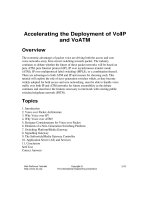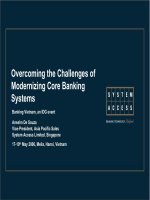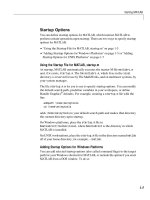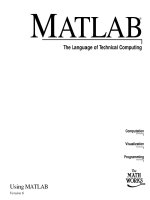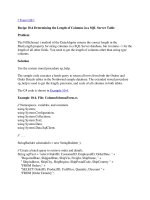Tài liệu SAVE THE PIXEL THE ART OF SIMPLE WEB DESIGN doc
Bạn đang xem bản rút gọn của tài liệu. Xem và tải ngay bản đầy đủ của tài liệu tại đây (751.56 KB, 11 trang )
1
© Ben Hunt 2008
Contents
Preface: The Art of Simple Web Design
The essence of the “Save the Pixel” philosophy; web design disciplines, including “Enough and no
more”, Occam's Razor, “Design the Content – not the box”, and “Think-then-do”.
1. Why are we here?
Knowing your own purpose; tips to get simple, realistic, specific goals; applying “Think-then-do”
to goals.
2. Make a site for its visitors
Your visitors are your friends! Clarify who's going to use your web site, what they want, and what
signs will check the little boxes in their heads; Affirming positives.
3. Spread the smell of success
How to retain visitors' trust and achieve the site's goals by moving visitors smoothly towards
their own goals; Win-win solutions.
4. The simple shall inherit the world wide web
How simplicity is good for everyone – and good business sense; the power of conventions; when
to break conventions; be smart, not clever.
5. Getability and the brand
How to make every page on your web site instantly understandable; How to develop a brand for
the web.
6. Layout
The first goal of layout is great getability; understanding and assigning screen real estate;
columns; cascade; ownership & containment; focal point.
7. Navigation
Navigation helps people know where they are, where they can go, and gives them the means to
get there easily; what mechanisms to use; what options to show; labelling navigation options;
ordering your options.
8. Noticeability
How to manage the visitor's attention to help them stay on the site and find what they want;
how to use size, contrast, boldness, colour, space, illusion of 3D, and movement to manage the
eye and draw attention to the most relevant elements; how noticeability changes down the
page; ignorability.
9. Give me space
The vital importance of space in noticeability; how to get the right balance; the golden rule of
spacing; space should be relative to size; why space is better than pixels.
10. Design your content
Great web page design keeps the focus on meaningful content, not on the background that's
common to every page; tips for writing better text and using imagery effectively.
2
© Ben Hunt 2008
Preface:
The Art of
Simple Web
Design
“See first that the design is wise and just:
that ascertained, pursue it resolutely;do not for one repulse forego
the purpose that you resolved to effect.”
William Shakespeare
“Delay always breeds danger
and to protract a great design is often to ruin it.”
Miguel de Cervantes, 1547 - 1616
3
© Ben Hunt 2008
It's hard to find information on how to be a designer
You can easily find loads of stuff in books or online to inspire you about beautiful graphics, and
plenty of technical know-how on CSS, HTML and code. But if you want to find out how to be a
web designer, structure a site that succeeds, decide on layout and craft pages that work, there
are very few resources available.
For the past 4 years, I've run a site called Web Design from Scratch (webdesignfromscratch.com),
where I've published articles and tutorials about the discipline of web design. It has been read by
millions of people world-wide.
This book aims to sum up my approach to web design in a series of new tutorials, each
illustrated with worked examples where my design team and I redesign a real web site home
page. I'll explain the reasons behind all our design decisions, which demonstrate the “Save the
Pixel” philosophy in practice.
What this book will give you
Insight into professional web design discipline that will help you create successful web
sites and page designs with less time and effort
Principles to help you select the design solution that's most likely to work, and to direct
your creative energy effectively
Dozens of practical techniques and tips on information architecture, page layout,
copywriting, graphic design etc.
Simple solutions
The goals of each web design can vary greatly from one project to the next, but we should always
strive for efficiency and simplicity. This will deliver a cleaner result that facilitates accurate
communication with less margin for error. It also takes less work to make something simple than
it does to make something complex.
When crafting a web page, I aim to use as few “things” as I need to achieve the purpose.
“Things” includes pages, words, pictures, choices, gradients, borders, boxes, graphics, columns
etc. etc
This helps make each step seem more obvious and feel easy.
Feeling easy is more important than being easy. In a way, it’s more real than actual
practical ease of use, because we’re more likely to persevere and succeed with something
we think is easy than something that seems a bit more complicated.
Chopping complex processes into simpler steps, makes them feel easier, which in turn can
lead to more success.
This approach isn't new. Economy has always been one of the core disciplines in Art and in
Design. The Old Masters were masters of economy. Look at the brush strokes on an old painting,
and you’ll see how much people achieved with so few strokes. It’s not that they didn’t have the
talent, or the time, to do more strokes, it’s just that they knew that using as few strokes of the
brush as possible to create the desired effect produces the best result. Using rougher strokes on
areas like backgrounds or material on clothing helped the eye to focus on the finer detail.
The same goes for web design. While your mode of interaction with a web site is very different to
a painting, a lot of the principles that artists have used for centuries can apply to any medium.
Web designers should follow the same discipline to apply only as much detail as is necessary,
putting it where it’s most needed, to manage viewers' attention.
4
© Ben Hunt 2008
Saving pixels
Edward Tufte has probably explored the visual communication of
information more than anyone ever. When Tufte writes about
communication in print, he refers to “saving your ink”, meaning that
you should use as little “ink” as you can to get the information across. If
you can use one less line, one less dot, one less word, while retaining
the meaning, you should.
For further reading I recommend Tufte's book “Envisioning
Information”.
In web design, we don’t use ink. We use pixels. Join me on the campaign to “Save the Pixel”.
When you’re designing, use only as many images, lines, CSS definitions, boxes, pages, forms,
changes in colour, changes in style, etc. as you need to get your stuff across. Always assume that
your visitor's attention span is limited, and that knowledge will help guide your choices.
Yeah, yeah, something about attention span
Like an elevator pitch for a new business, a sales pitch on the street, or a billboard ad, if you can
get your message across in ten seconds, why take twenty? If you can do it in 9, why take 10?
When someone arrives at a web site, you have a limited amount of attention available. How
much time that equates to is unknown. It depends on the competition, visitor's expectations, and
how badly they need what your site offers. And when you only have a limited amount of
attention, there is a limit to the number of signals you can convey. So aim to make every signal
relevant, significant, and helpful .
The more efficiently you can communicate what you have to get across, the more likely you are
to keep your visitor's attention, and the greater your success. If you can increase sales,
conversions, or brand retention by 5%, that’s a win. We should never accept second-best.
Your job is firstly to make the visitor trust your web site, by making your web page “getable”, so
that your visitor believes “I'm in the right place to get what I want”. This means you first need to
have insight into your visitor's goals, and the triggers that will give them positive vibes, with a
brand and a message that's immediately accessible. If you can achieve that, they will look for the
next step.
Then your job is to keep the “scent”, so that they continue to think, “I’m going to get what I want
here”. You’ve got a limited opportunity to do that. If they feel overwhelmed, or decide for any
other reason that they’re not going to get what they’ve come for, you could lose them. Focus on
making the next steps forward obvious and easy, and you’ll keep them moving smoothly towards
their own goals (and achieving your goals along the way). The key factors here are managing
noticeability on every page with a mind to saving the pixel, laying out visual elements in an
economical and readable way, and making optimal use of imagery and words.
“Enough, and no more”
One of the touchstones of my design philosophy is “enough and no more”. How many pages
does your site need? How many options? How many paragraphs should it take to describe
something? How many icons, pictures, photos, headings, lines, drop-downs, callout boxes, shiny
gradients, logos, colours, columns etc. etc. etc. does your site need? The answer's always the
same: “Enough and no more”.
All you need to do is enough. You need to provide enough images and information for your
visitor to know they’re still on the right site, enough options to be able to choose the next step
forward with confidence… And no more!
5
© Ben Hunt 2008
One thing too many may overload your visitor's attention span.
Pixel-saving discipline
Get into the habit of challenging every single design decision, asking: Can it be made simpler,
without losing the essence of what the page has to achieve?
Every bit of complexity that you add to a page brings with it the risk of breaking your visitor's
attention span. Every element that could draw the eye, every box, every line, every pixel, should
be there for a reason.
● Does it convey important information?
● Does it contribute significantly to the brand?
● Does it help your visitor know “I'm in the right place” or “This is the way to get
what I want”?
Simplifying every visual element brings numerous advantages:
□ It's quicker to implement less than more, which means you can take more time to
concentrate on understanding the business challenge, getting into your visitor’s heads,
clarifying goals, and getting the big picture.
□ Less is much easier to code than more. A flat coloured box is much easier and quicker to
code than a coloured box with 4 rounded corners.
□ Simpler pages take fewer resources to download, and less bandwidth, so render more
quickly. That increases your success rate too.
□ You'll always need to make changes. It’s easier to change less than it is to change more.
How to choose what to include & exclude: Occam's Razor
Occam's Razor is a logic principle that says: Given any two solutions to the same problem, all
other things being equal, the simplest solution is the best.
In other words, if you can achieve the same effect with less, do it.
Likelihood of success is proportional to amount of visitor attention, divided by the amount
of stuff they have to look through to get what they need next.
Now, we can't do much about attention: it's pretty much a finite resource (although we should
do our best to keep our visitors alert, awake and eager). We have much more control over the
amount of stuff on each page.
Pro Designer Discipline
“Save the pixel” sums up my whole design philosophy. The more simply you can achieve what
you need to do, the better. (It may help to imagine that pixels are a precious resource.)
“A recent UN report estimates that, at the present rate of consumption, the world supply
of pixels will be exhausted by the year 2050.”
Pro designers learn to work smart. They do as little action as possible to achieve what needs to
be done, and use as much thought as is required to be able to do this.
6
© Ben Hunt 2008
The general approach goes like this:
1. What the heck it is you’re doing here?
2. How are you going to achieve it by helping other people achieve what
they want to do?
3. What steps need to happen, and what information needs to be
communicated?
4. Then how do you arrange everything onto pages in such a way that
your messages are communicated effectively, and everyone finds your
site easy and pleasant to use?
This process starts with you as a designer getting your head in the right place.
Design isn't Art.
It's not about creating beautiful or thought-provoking things for the sake of it.
Design is a discipline – creating communication with a purpose.
In this book I'll start with the core stuff – you, your mind, and your design discipline. There's a
world of skills you could learn; some are more useful than others, none is essential. But,
whatever your skillset, if you can learn how to apply a few simple positive disciplines, you'll work
more effectively and make the most of your time and energy.
Design the content, not the box it comes in
Use your pixels on things that communicate meaning. It used to be very common for web
designers to make just templates – attractive or jazzy containers which would have “content”
added at a later time. This is a fundamentally wrong approach, because it doesn't fulfil the
designer's mission - facilitating communication.
If you find yourself decorating the package, rather than crafting real, meaningful content, stop &
ask: “Are these pixels best used here?”
You want the visitor to focus on the navigation & content as that's where the signposts are that
point to the goals.
If a design feature makes it 1% more likely that someone's eye will be drawn to a non-
useful visual element, the only way it can go is that more people will be lost. Either they'll
get fed up & give up at that point, run out of time, get confused, or guess and take a
wrong turn and then get confused.
It's a percentage game, and it's the designer's job to optimise the percentages to get more
people through to satisfactory outcomes.
“Packaging” elements that are repeated on every page are pretty dead. They communicate once
and then get ignored and can't communicate much more, so pixels spent on decorating the “box”
are less effective. (Of course, some things need to be communicated on every page – to help
answer the question, “Am I in the right place?”.)
Drawing the eye to dead features is counter-productive. The modern approach is to keep the
branding/box design strong but minimal, devoting more energy and pixels to content.
7
© Ben Hunt 2008
Case Study: I Hate Clowns
8
Note how much detail
there is in the
background, how
many pixels have
been used to
decora te the low-
value areas of the
design.
Intense colour
around the edges of
the screen draws the
eye away from
content.
The redesign us es far fewer pixels. There's less
activity, less to look at. The result is that all the
features that are on the page can be stronger and
clearer.
While everything is bigger and bolder, the overall
effect is easier on the eye.
original
redesign
© Ben Hunt 2008
Think-Then-Do
“Think-Then-Do” is a key component of my design process. It's centred around the 2 specific
activities you have as a designer: decision-making and execution, and combining them to
produce the best results as efficiently as possible.
1. Think
The first part of the cycle is strictly hands-off. It involves sitting back, looking at your design or
problem with fresh eyes, then deciding quickly, boldly and objectively “what needs to be done”.
Forget that you're the one who's going to have to do it. Make bold decisions as though someone
else will carry out the work.
Separating thinking from doing can help you bravely face the real core of the problem.
Does it all need throwing away & starting again? Is the layout fundamentally flawed? Are
the colours wrong? Is there the wrong number of pages? Should this site actually be two
sites?
Make clean, correct decisions, then switch hats and proceed to step 2
2. Then Do
Once you're clear what needs to be done, stop all analysis, and apply the JFDI process (“Just
F***ing Do It”).
Do your job, as though your boss has told you what you have to do, and you have no choice in
the matter. (In this discipline, the Think part of you is the boss.) The trick is to work rapidly and
selflessly, without criticism, just moving forward.
3. Repeat
Once you've done what your Thinking brain specified, take a break, do something else, then go
back again & repeat the process, starting again with thinking.
It's difficult to do both these steps at the same time. It's often really hard to analyse and make
decisions while you're working on something, and there's a tendency to take what seems to be
the option that requires less work, even if it sometimes means avoiding difficult problems.
In fact, it can be much quicker and more efficient to work this way, even when it involves
taking big decisions that lead to drastic action. If the tanker is heading the wrong way,
although it's hard to turn it around, the sooner you do turn it around, the sooner you'll
reach your destination.
When you're working with a clear, balanced purpose in mind, subsequent decisions seem to flow
much more easily. Trying to build a solution from the wrong foundations is like swimming
upstream – everything is hard work.
Keep fresh eyes
Think-then-do requires you to work in short bursts of activity, with multiple cycles of Thinking
and Doing.
This helps you to avoid what I call “screen-blindness”. You may recognise the phenomenon if
you've ever spent several hours working on a design. The longer you work, the more slowly you
seem to get results. You find yourself sitting staring at the screen, pushing pixels around one way
than back again. You lose touch with what it is you're trying to do. You're screen-blind.
Later, you come back to the design after a break, and you just “see” what's right and wrong! You
sit down, and five minutes later the design is almost done. This is think-then-do at work.
9
© Ben Hunt 2008
One of the clearest indicators of screen-blindness, for me at least, is the tendency to reduce the
tonal contrast in a design. When we look at web pages in the real world, we're scanning for clues
to what we want, and pages benefit from plenty of crisp contrast to help you tell things apart
quickly and easily. When you've been staring at a design for too long, strong contrast and colour
start to feel too much, and you find yourself softening everything. Look out for this sign, and take
a break whenever you sense it happening.
When you follow think-then-do, you only start working on a design once you have a clear intent
in mind. And you stop when you've implemented what you were going to do. At these points, it's
good to walk away and do something else for a short time, then come back and Think again.
Then Do. Repeat until done.
Case Study: JBS Partners
JBS Partners is the marketing site of web consultant Jim Spencer.
10
original
What do you notice first?
The most noticeable thing
on the screen is the
graphic of the 2
busines speople walking.
This graphic has little
informational value, and
the colour feels cold &
remote.
The content of Jim's site
suffers from being hard to
notice. The text is
dominated by the solid
blue bar, lines are quite
long (which is more tiring
to read), and nothing
draws the eye to the good
information.
© Ben Hunt 2008
We hope you enjoyed this free chapter
Read the full e-book to learn more about creating web sites that
are appealing, easy to use, and successful through the Art of
Simple Web Design.
Get the full book at />If you'd like to be kept informed with news and
offers regarding Save the Pixel, please subscribe
to my email newsletter at
/>newsletter.php
11
Although the site has a
strong visual mood,
the content is also
much more noticea ble
and readable, thanks
to strong headings,
reduced amount of
text on the page,
larger font size and
shorter line length.
While everything has
been made easier to
rea d, notice how the
most useful elements
have been given
greater relative
prominence with
increased size.
© Ben Hunt 2008
redesign

